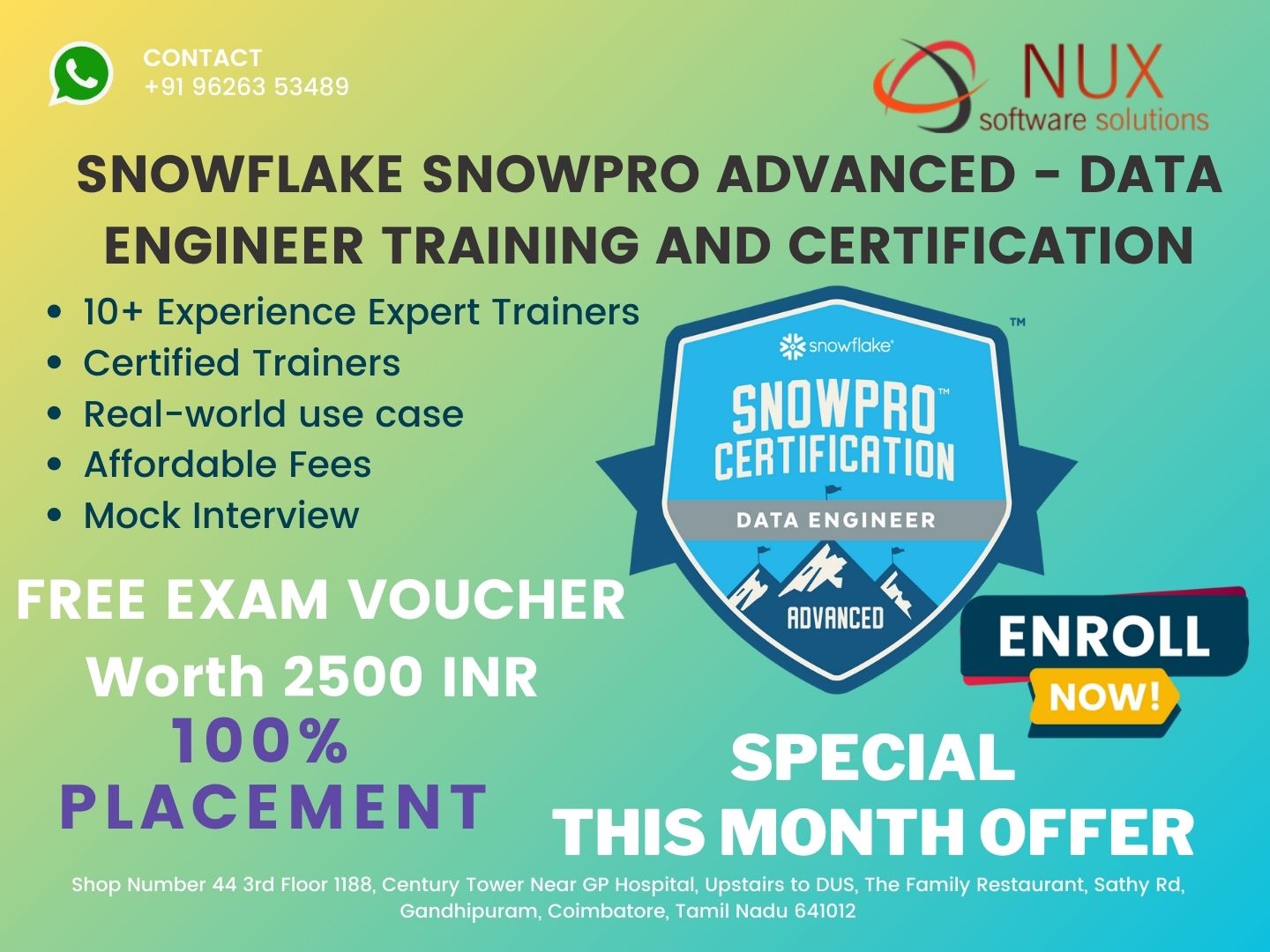Snowflake SnowPro Advanced – Data Engineer

Course Summary
The SnowPro Advanced: Data Engineer certification is designed for professionals responsible for developing and maintaining data pipelines, transforming raw data into trusted assets, and implementing engineering best practices on the Snowflake Data Cloud. This training goes beyond SnowPro Core to focus on advanced ETL/ELT design, automation, orchestration, data modeling, and performance tuning — essential for building scalable and efficient data engineering workflows in Snowflake.
This course prepares participants for real-world responsibilities as well as the SnowPro Advanced: Data Engineer certification exam, positioning them as specialists in modern data engineering using Snowflake.
Why Choose This Course
As organizations shift to cloud-native data platforms, skilled Snowflake data engineers are in high demand to build pipelines that are reliable, high-performing, and cost-efficient. This course:
Focuses on real-time and batch data engineering practices
Equips learners to design enterprise-scale ETL/ELT pipelines on Snowflake
Covers performance optimization, automation, and DevOps integration
Includes advanced use of SQL, Snowpipe, Streams, Tasks, and third-party orchestration tools
Prepares participants to take and pass the SnowPro Advanced: Data Engineer exam
Led by certified trainers with hands-on Snowflake engineering experience, the course is rooted in practical application and industry relevance.
Who Should Enroll
This course is ideal for:
Experienced data engineers working on Snowflake or other cloud data platforms
ETL/ELT developers looking to upskill for the cloud
Professionals preparing for the SnowPro Advanced: Data Engineer certification
Cloud engineers or DevOps practitioners supporting data pipeline infrastructure
Data professionals seeking to deepen their SQL automation, scheduling, and optimization skills
Skills You Will Gain
Designing and managing complex ELT pipelines in Snowflake
Advanced use of Streams, Tasks, and Snowpipe for real-time ingestion
Handling semi-structured data (JSON, Parquet, Avro) and variant types
Performance tuning using clustering, caching, and query optimization
Automating workflows using tools like Airflow, dbt, or CI/CD pipelines
Monitoring, troubleshooting, and optimizing data flows across workloads
Career Benefits
After completing this training, you will:
Be ready to pass the SnowPro Advanced: Data Engineer certification exam
Qualify for roles like Senior Data Engineer, Snowflake Data Engineer, or Cloud ETL Specialist
Gain credibility in managing large-scale data pipelines for analytics, AI/ML, and business intelligence
Be prepared to work in multi-cloud, cross-platform data environments with Snowflake at the center
Build a skill set that aligns with the modern data stack used in enterprises globally
Engineer Smarter Data Pipelines with Snowflake
Data engineers power the future of analytics and AI. This course empowers you to build resilient, efficient, and high-performance data pipelines using Snowflake’s cloud-native features.
Get certified. Get noticed. Get ahead.
Snowflake SnowPro Advanced - Data Engineer Syllabus
Modules
Data Movement - 28%
- Given a data set, load data into Snowflake.
Outline considerations for data loading
Define data loading features and potential impact
- Ingest data of various formats through the mechanics of Snowflake.
Required data formats
Outline Stages
- Troubleshoot data ingestion.
Identify causes of ingestion errors
Determine resolutions for ingestion errors
- Design, build and troubleshoot continuous data pipelines.
Stages
Tasks
Streams
Snowpipe (for example, Auto ingest as compared to Rest API)
- Analyze and differentiate types of data pipelines.
Create User-Defined Functions (UDFs) and stored procedures including Snowpark
Design and use the Snowflake SQL API
- Install, configure, and use connectors to connect to Snowflake.
- Design and build data sharing solutions.
Implement a data share
Create a secure view
Implement row level filtering
- Outline when to use External Tables and define how they work.
Partitioning external tables
Materialized views
Partitioned data unloading
Performance Optimization - 22%
- Troubleshoot underperforming queries.
Identify underperforming queries
Outline telemetry around the operation
Increase efficiency
Identify the root cause
- Given a scenario, configure a solution for the best performance.
Scale out as compared to scale up
Virtual warehouse properties (for example, size, multi-cluster)
Query complexity
Micro-partitions and the impact of clustering
Materialized views
Search optimization service
Query acceleration service
- Outline and use caching features.
- Monitor continuous data pipelines.
Snowpipe
Tasks
Streams
Storage and Data Protection - 10%
- Implement data recovery features in Snowflake.
Time Travel
Fail-safe
- Outline the impact of Streams on Time Travel.
- Use System Functions to analyze Micro-partitions.
Clustering depth
Cluster keys
- Use Time Travel and Cloning to create new development environments.
Clone objects
Validate changes before promoting
Rollback changes
Security - 10%
- Outline Snowflake security principles.
Authentication methods (Single Sign-On (SSO), Key pair Authentication, Username/Password, Multi-factor Authentication (MFA))
Role Based Access Control (RBAC)
Column Level Security and how data masking works with RBAC to secure sensitive data
- Outline the system defined roles and when they should be applied.
The purpose of each of the system defined roles including best practices usage in each case
The primary differences between SECURITYADMIN and USERADMIN roles
The difference between the purpose and usage of the USERADMIN/SECURITYADMIN roles and SYSADMIN
- Manage Data Governance.
Explain the options available to support column level security including Dynamic Data Masking and External Tokenization
Explain the options available to support row level security using Snowflake Row Access Policies
Use DDL required to manage Dynamic Data Masking and Row Access Policies
Use methods and best practices for creating and applying masking policies on data
Use methods and best practices for Object Tagging
Data Transformation
- Define User-Defined Functions (UDFs) and outline how to use them.
Snowpark UDFs (for example, Java, Python, Scala)
Secure UDFs
SQL UDFs
JavaScript UDFs
User-Defined Table Functions (UDTFs)
- Define and create External Functions.
Secure external functions
Integration requirements
- Design, build, and leverage Stored Procedures.
Snowpark stored procedures (for example, Java, Python, Scala)
SQL Scripting stored procedures
JavaScript stored procedures
Transaction management
- Handle and transform semi-structured data.
Traverse and transform semi-structured data to structured data
Transform structured data to semi-structured data
Understand how to work with unstructured data
- Use Snowpark for data transformation.
Understand Snowpark architecture
Query and filter data using the Snowpark library
Perform data transformations using Snowpark (for example, aggregations)
Manipulate Snowpark DataFrames



